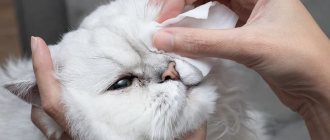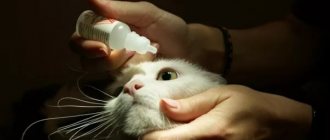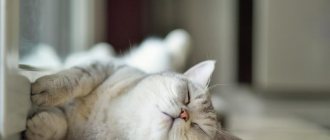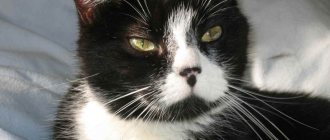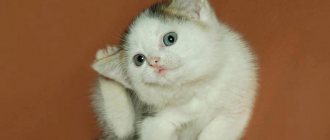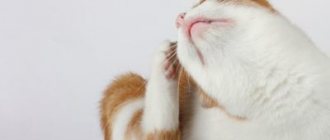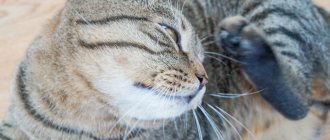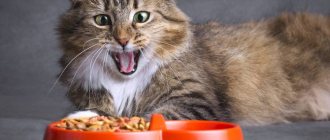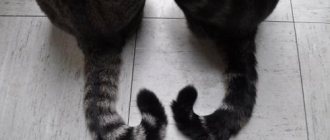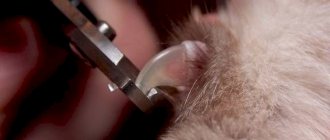Tail signs
The tail is the most powerful indicator of a pet's condition. It can be considered a kind of mood indicator. What can he talk about?
If the cat is irritated or interested in something, it will wave the tip of its tail from side to side. Such twitching indicates a slight degree of irritation, which can develop into an aggressive manifestation of dissatisfaction.
When a cat flicks its tail sharply up and down, it is showing strong excitement and anxiety. His hair stands on end and he becomes fluffy. She gets very angry and is ready to attack. In this state, it is better to leave the animal alone.
Depression and a state of fear are characterized by a tail clamped between the legs. In order for the cat to calm down, it is necessary to eliminate the source of danger.
A raised tail with a straightened or slightly curved tip expresses the joyful state of a pet. Conversely, a drooping tail shows the animal is tired or disappointed.
If the tail trembles, it means the animal is marking its territory.
Another simpler pattern of tail signs in cats.
Causes of squinting eyes in cats
The cat's eye is an incredibly sensitive organ, so quite often it can be susceptible to inflammatory processes and the development of various pathologies. Many diseases can manifest themselves in this way when cats squint their eyes.
Let's take a closer look at the reasons for this phenomenon.:
- The presence of conjunctivitis is an inflammatory lesion of the mucous membrane of the eye. The disease is accompanied by swelling of the eyelids, mucous and purulent discharge. The affected eye becomes red and itchy, and a bluish or white cloudiness may also appear on it. To treat pathology, special eye drops are used, and rinsing procedures are also carried out. In later stages of the disease, antibiotic injections may be prescribed.
- Corneal erosion is damage to the cornea of the eye. An equally common reason why a cat squints one eye. The causes of the development of the disease are viral infections, injuries, burns, and glaucoma. Untimely treatment leads to the formation of a serious pathology - a corneal ulcer.
- Mechanical injuries to the cornea , which are always accompanied by severe pain and, as a result, the cat begins to squint its eyes. The insidiousness of such injuries lies in the penetration of pathogenic microorganisms into the depths of the tissues of the eye, where they further multiply. You should be especially careful about eye injuries caused by cat claws, since a large number of dangerous bacteria and worm eggs accumulate under them.
- An increase in eye pressure , which occurs due to age-related changes and the old age of the animal, is also a possible reason that the cat squints the visual organ. Due to the lack of proper treatment, this condition can predispose the cat to the development of one-sided blindness.
- Allergic reactions to flowers and plants , dust and household chemicals often cause a kitten to squint its eyes. A veterinarian will help identify the causative agent of the allergy and prescribe appropriate medications.
Sight
The visual organ reflects well the mood of the cat. If the pet is in a calm mood and does not feel danger, then its eyes will be closed or half-closed. This is how he expresses his trust.
A cat shows curiosity through wide open eyes. So she studies the world around her with interest. But there is another meaning. An open gaze can indicate fear or aggression. In this way she tries to scare the enemy. Most often, this look can be found in fighting cats.
Cats do not like direct and long eye contact. They perceive this behavior as a challenge.
Why can a cat squint only one eye?
It is important to distinguish between cases when an animal squints with pleasure, covering both eyes, and when it has only one squinted. If it covers only the left or right eye, then something is preventing him from opening it completely. We need to find out the cause of this problem as quickly as possible. The slightest delay in some cases can lead to the loss of a diseased organ by the pet.
Foreign body in the eye
While walking while exploring secluded corners, your four-legged pet may get a speck or dirt in its eye. The foreign body will prevent him from blinking, so he will cover the affected organ. You can tell that your pet has got something in its eye by the following signs:
- increased rubbing with the paw;
- frequent blinking and squinting;
- increased lacrimation;
- redness.
Ear positions
Ears are no less informative. There are a number of emotions that are expressed through the position of the ears. For example, ears pressed to the head indicate the animal’s aggressiveness and readiness to attack. Twitching in the direction from the eyebrows to the back of the head expresses his excitement.
A cat's playful state or desire to hunt can be determined by its forward-pointing ears. An upright position signifies interest in things around you.
Paw movements
Trampling or fingering its paws means that the pet is happy and satisfied. If the cat is alert, it will freeze with its front paw raised.
When an animal lacks attention or affection, it will touch the owner with its paw.
Squatting on the front legs means an aggressive attitude and readiness to attack. Squatting on its hind legs may indicate confusion in your pet.
Dictionary of cat sounds
Purring - calmness. Dissatisfied purring is a painful sensation. Rumbling is dissatisfaction. Meowing is a greeting and sometimes a request. An intermittent meow, similar to a squeal, is a response to human treatment. Howling is anger. A short cry is fear. Muffled purring, ending with a dissatisfied rumbling - patience has run out. Hissing is a readiness for defense, a warning about this. The restrained purr of a nursing cat is a warning to kittens about possible danger. The same thing, ending with a raised tone - a warning to a person or other creatures not to approach the kittens.
Body movements
A cat shows its affection and trust in its owner through friction against a person’s leg. This behavior indicates a relaxed state of the animal, which is begging for something, for example, affection. She also tries to leave her scent on a person as a sign of affection.
If an animal accompanies its owner, turning its body towards him, while simultaneously meowing and rubbing against its legs, it means it is expecting something.
When a cat assumes a position with its front paws tucked under itself, it means it is feeling unwell. She may be experiencing pain or physical fatigue. Her state is not relaxed.
If your pet is curled up in a ball, it means he feels good, warm and cozy. She is happy and calm.
The cat lies with its spine and tummy stretched out. She takes this pose when she lacks care and attention. At this moment it is advisable to stroke her. The abdominal area should be avoided, as this is their most sensitive area, touching which can cause an attack. In this case, everything will depend on the character of the pet. If the character is affectionate, then the biting will be light.
This pose has another meaning. In this position the animal can repel an attack.
The state of aggression or fear is symbolized by the following pose: the cat stretches out on its paws, arches its back, its fur stands on end, its ears are flattened, and its fangs are exposed. This position indicates its readiness for military action. For small pets, this position is typical during games.
If a cat sneaks slowly or stands motionless, pressed to the floor or ground, its eyes are open and concentrated on the target, and its tail is straight, then it is aiming to catch prey.
Lying on your side with your paws extended conveys relaxation and safety. When an animal is interested in watching something, it simply sits down and tucks its paws, hugging them with its tail.
The “Column” position (the cat has taken a vertical position, sitting on its hind legs, eyes wide open) shows the pet’s curiosity. She wants to understand what is happening around her.
Cats can't talk. But with the help of different gestures, she can show her mood and emotions: humility, a friendly attitude, arrogance, anger or resentment.
By studying cat habits, living with a pet can be made more enjoyable and comfortable.
Source
Paws
Paws play a big role in the communication between a cat and its owner. If it “stomps” and shifts from paw to paw, while purring and spinning, then this is an expression of love and goodwill towards a person. This is the highest manifestation of tenderness and trust.
Also, by lightly touching their paws, cats can simply attract a person's attention. For example, for him to stroke.
But extended claws and sudden movements of the paws indicate that the cat is unhappy with something and is angry. As a rule, this gesture is combined with corresponding facial expressions and body posture: ears are flattened, fur is raised.
Cat sign language
If you think that cats only know how to meow, then you are very mistaken. Felinologists distinguish 16 sounds that our pets make, including seven consonants: M, N, G, X, F, V, R. Experts have even compiled a dictionary of the “living great cat language.”
Possible duplicates found
Yes Yes! That is, my Cat respects me madly and endlessly, now everything is clear
